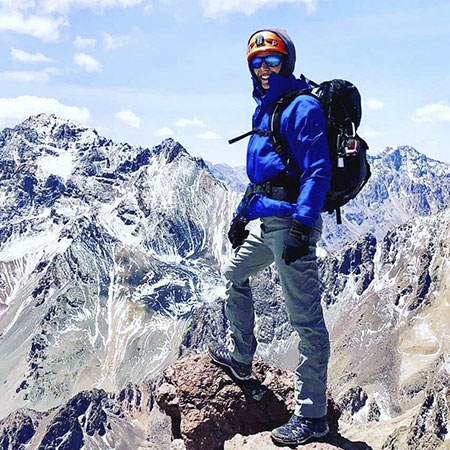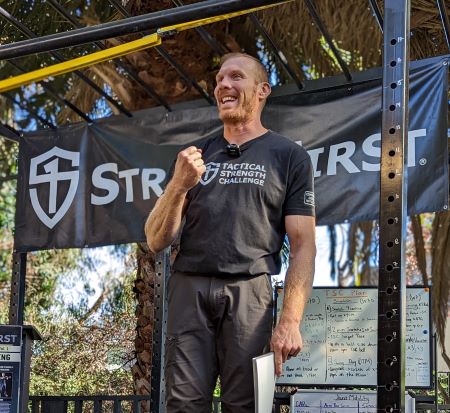
A growing population of endurance/ultra-athletes and coaches are moving towards StrongFirst programming. These athletes and coaches bring questions on program design utilizing Strong EnduranceTM protocols. In this article, I will share the snatch walking plan I’ve designed using one of these protocols. Most of my students use this plan at the end of many months of protocols from The Quick and the Dead by Pavel. However, one of my students, Mia, utilized it at the beginning of her training so she could achieve a greater benefit from The Quick and the Dead protocols that my other students start with (side note: Mia will be attempting multiple speed records on Mt. Aconcagua—more on this later). Determining whether you should start with snatch walking or finish with it is a matter of your training history. Let’s take a closer look at this by covering a few examples.
Building Endurance Without the Miles
First, it’s important to understand that building a high level of endurance capacity is about more than simply putting on miles of training. Let’s think about one aspect of endurance by considering a hypothetical deadlift competition. The first competitor has a maximum deadlift of 400 pounds, and the second competitor’s maximum is 600 pounds. Who can perform more repetitions at 300 pounds without dropping the bar? Without a doubt, the person whose maximum is double the tested weight would find this test significantly easier. Does this person have better muscular endurance, or does it just seem that way because the tested weight is more submaximal to them? Honestly, it doesn’t really matter. The truth is they would easily perform better at the test. This might sound like an extreme example for endurance athletes, but it really isn’t as far out as you’d think. Collin O’Brady, the first to cross Antarctica unassisted on foot, began his trek pulling a sled weighing over 400 pounds.
A real example of this type of endurance is John Brookfield’s “Tower of Terror.” This consisted of snatching a 48kg kettlebell, locking it out bottoms up, and flipping it twice on the way down before catching it and snatching again. He did this for 20 repetitions. John also performed more than 300 repetitions in a 10-min snatch test using a 24kg kettlebell. Yes, that’s 150 repetitions in a 5-min SFG snatch test twice back-to-back. At that pace, a 10-min kettlebell snatch test could be considered similar to running two miles as fast as possible. This isn’t an ultra-athlete performance like Collin’s, yet again, because John is so strong, he can outperform most people in this 10-min test of endurance.
If you’ve always looked at building endurance through many miles of training, perhaps these examples have begun to catch your attention. However, let’s explore a real ultra-endurance example and how this snatch walking plan began. After listening to Pavel present Strong Endurance, on four separate occasions, I began to see a way to build capacity for ultra-events by putting his protocols into a progressive order. This order started with the heaviest weights, lowest volume, and lowest density. It built toward lighter weights, higher volume, and greater density. This progression seemed natural to me, because I have a strength background and wouldn’t have been able to jump directly into the more enduring protocols without building toward them. Therefore, my personal program concluded with the snatch walking progressions. After six months of training, I was able to run 3 x 7-minute miles (7-min rest between each) while breathing entirely through my nose. This may not seem extraordinary to an elite runner, but I hadn’t run throughout the entire six-month plan. I also tested my new endurance in the mountains, accomplishing seven peaks in eight days. These mountains were all over 13,700 ft. The effort pushed over 26,000ft of vertical increase and covered 65 miles. This caught the attention of a few of my students who also wanted to summit these aggressive mountains. They utilized the training plan and conquered their objectives with ease.
Working Backwards
After these expeditions, I was thrown a twist. Mia Farrow caught word of my programming through her trainer, Peter Kirk, in Australia. Mia will be attempting 3-4 world records (some will be the fastest known times or FKTs) on Mt. Aconcagua next month. At 22,837ft, Aconcagua is the second tallest of the world’s seven summits. Mia’s main objective will be a 110km event that crosses the summit, while also circumnavigating the mountain. This task will be done in one push of 35-47 hours. The twist, for my programming, was that Mia wasn’t coming from a StrongFirst background. Instead, she had a very large endurance background. I felt she wasn’t quite strong/powerful enough to perform the protocols in the order I had designed for myself and my other students. However, the high volume, high density, and lighter weights of snatch walking was a comfortable place for her to begin.

Plans like 015, 033, and 044 (read The Quick and the Dead for more information on these) would have had less impact if we started with them. She was unable to swing or snatch a large enough weight to effectively recruit the correct muscles and energy system needed to build capacity the Strong Endurance way. So instead, we started her with the most enduring protocol (snatch walking) in order to play to her strengths. We worked backwards in the progression, slowly increasing the weights she used while decreasing the volume and density. After a high volume of snatching 8-10kg, it was an easy transition to snatching 12kg and even 16kg in Plan 044. This also allowed us to jump even higher when changing from snatching protocols to swing protocols. By the time she got to Plan 033, Mia was swinging 28kg. She didn’t actually have a 28kg kettlebell, so she did asymmetrical two-arm swings with 12kg in one hand and 16kg in the other, alternating hands each set. This allowed her to work on anti-rotation and stability. Considering her sport, offset swings were an effective addition. Having a greater load on one side has a large carry-over into carrying an odd pack while traversing the side of a hill or mountain. Had we started with Plan 033, a 16kg kettlebell would have been her choice, and it would have had a smaller impact on building strong endurance.
Time will tell whether she gets these records, but, for now, her hip power is better, she’s stronger, her joints are more stable, and she’s primed for success (side note: Mia also continued her run training throughout this process).
Even though Mia started with the snatch walking protocol, and my other students ended with it, I’m excited to bring her back to it after her expedition is complete. She is now strong, first, and will likely gain even more benefit from snatch walking now that she feels 8-12kg is significantly lighter.

The Snatch Walking Protocol
Let’s dive into the procedure.
Kettlebell size:
Men—12kg to 20kg
Women—8kg to 12kg
Method:
Snatch the kettlebell, lower it from the lockout to the rack position, take one step forward, drop the kettlebell from the rack, and then snatch again. Repeat. Switch hands every 5-10 repetitions.
Stop if you:
- Cannot pass the talk test at any point.
- Feel an RPE greater than 7 on a scale of 1-10.
- Lose the ability to breath in on the hike pass and out when the hips finish each rep
(breathing during the rack or forward step should be natural).
- Change your technique in any way for any reason.
- Reached your time limit for the session.
The first progression time limit is 25-min.
Perform this protocol 1-2 times a week. If you do it two times a week, always do 20{32c02201c4e0b91ecf15bfd3deecd875caca8b9615db42cfd45ce3d8de8d0829} less in the second session.
Measure your distance—you’ll find this easier than counting reps.
When you can reach the 25-min time limit without hitting a stop sign, and your distance has increased by 10{32c02201c4e0b91ecf15bfd3deecd875caca8b9615db42cfd45ce3d8de8d0829} beyond the last 25-min session, increase the following week’s session to a maximum of 40-min.
When you can reach the 40-min time limit without hitting a stop sign, and your distance has increased by 10{32c02201c4e0b91ecf15bfd3deecd875caca8b9615db42cfd45ce3d8de8d0829} beyond the last 40-min session, increase the following week’s session to a maximum of 50-min.
Once you’ve built a comfortable capacity for 50-min, go back to The Quick and the Dead training Plans 033/044 before further progressing the snatch walk plan. The simplest way to progress this plan is to perform an overhead carry, rather than a racked carry, in between repetitions.
I’ll be heading to Mt. Aconcagua, in Argentina, to watch Mia attempt her records. I’ll also personally continue testing Strong Endurance training methods by attempting a summit of the mountain myself. Upon return, I’ll be excited to publish a recap of the events here. Stay tuned.

All-Terrain Conditioning™ Course
With Derek Toshner,
StrongFirst Certified Master Instructor
Seattle, WA or ONLINE, March 18-19
To learn how to build amazing capacity for adventure,
sign up today






